Nestlé Waters North America’s VP and chief sustainability officer discusses challenges, market constraints, and lessons learned as the brand increases rPET use across the US portfolio.
August 17, 2020
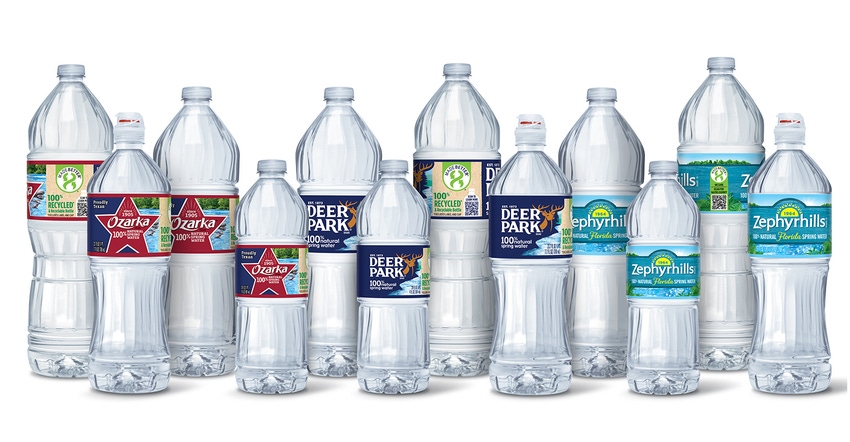
Nestlé Waters North America took a deeper plunge into recycled PET with a mid-July announcement that three more regional brands in its national portfolio of packaged water will join Poland Spring in using rPET content.
For many years 100% recyclable in PET bottles, the company’s regional brands’ packaging — Ozarka 100% Natural Spring Water, Deer Park 100% Natural Spring Water, and Zephyrhills 100% Natural Spring Water — will all be made using 100% recycled plastic and be 100% recyclable.
With the expansion, nearly 60% of all households in the U.S. will have access to one of the company’s bottled waters in 100% recycled packaging.
Key takeaways:
The packaging conversion for these three brands means that NWNA has doubled the amount of rPET used since 2019 across its U.S. domestic portfolio to 16.5%;
Brings the company closer to using 25% rPET across its U.S. domestic portfolio by 2021 and 50% rPET by 2025.
Using recycled plastic can help keep it out of landfills, waterways and oceans, and reduces greenhouse gases by 67% compared to using new PET, according to a 2018 report from Association of Plastic Recyclers.
All brands will include a new message on the labels of the 20oz, 700mL, 1L and 1.5L bottles, stating they are both 100% recyclable and are made from 100% recycled plastic.
Labels will also include a Quick Response (QR) code that allows people to scan and track the journey of the water they’re drinking, as well as the bottle.
In 2019, Poland Spring collaborated with The Recycling Partnership to launch the first Instagram recycling hotline to help Americans understand what is recyclable in their communities.
NWNA was also the first beverage company to add How2Recycle information on the labels of its major U.S. brands, reminding consumers to empty the bottle and replace the cap before recycling.
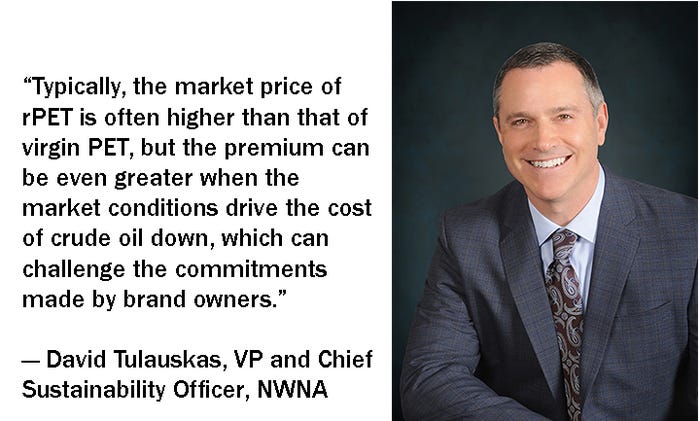
An interview with David Tulauskas, VP and Chief Sustainability Officer, NWNA, yielded the following highlights and details.
rPET sources are tight.
There is not enough supply for us and other beverage manufacturers to use rPET packaging for all SKUs of all of products.
Like other beverage manufacturers, we have made commitments to increase the use of recycled content throughout our portfolio. This includes our commitments to 25% rPET across our U.S. domestic still water portfolio by 2021 and 50% rPET by 2025. To achieve this, there needs to be a robust and stable supply of food-grade recycled content. Unfortunately, less than 30% of all plastic bottles are recycled and many recovered beverage containers are being down-cycled and used in non-food contact applications versus being made back into beverage containers.
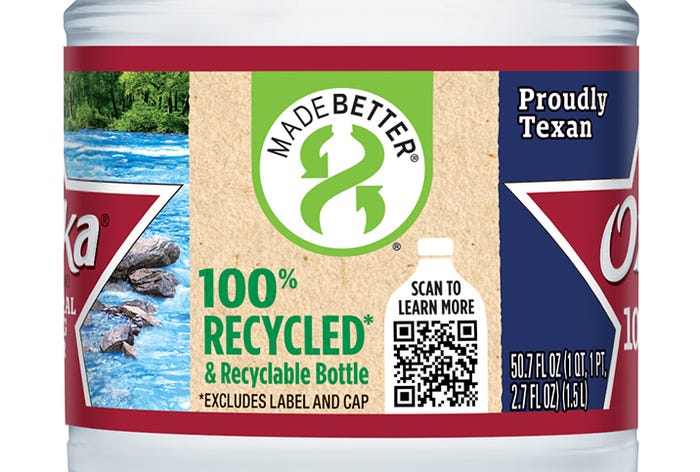
To create a continuous supply of recycled plastic, there needs to be a broad, collective focus by industry, government, and NGOs to address critical issues related to infrastructure, collection, policy, consumer education and development of end-markets for recycled materials. We are encouraged by the accelerated collaboration among these groups, and we will continue to work with them to help increase the use of recycled content in packaging, encourage packaging design that is compatible with the recycling system, improve the recycling infrastructure and curbside access and educate consumers about the impact they can make by recycling.
Recycled plastic does have a slight color.
However, we only use food-grade materials that meet our high-quality standards.
As for price, the raw materials used in the making of virgin plastic come primarily from oil, which has seen record lows as a result of the pandemic. Typically, the market price of rPET is often higher than that of virgin PET, but the premium can be even greater when the market conditions drive the cost of crude oil down, which can challenge the commitments made by brand owners. This is an investment we prioritize for the business, and we honor the commitments we’ve made to our suppliers as part of our responsibility to minimize our impact to the planet and strive for a waste-free future.
There's no intention to change the suggested retail price.
Conversion is harder than you may think.
Converting packaging from virgin PET to rPET is an important step – but is more complicated than it may sound.
It’s not business as usual and if it were easy to do, every company would be doing it right now. It requires a totally different approach to our supply chain. This includes longer-term contracts with a variety of suppliers; a collaborative approach to transition suppliers’ production lines to make food-grade rPET and to meet NWNA’s very rigorous quality standards; and changes to our own production process. As more beverage companies make this transition to using more rPET, it will help more suppliers to see the opportunity and will help create the demand for more supply. We’re not only re-imagining our own business, but also helping the industry to move toward a waste-free future.
Conversion to rPET started last year and included equipment adjustments.
We started to regularly use rPET in California with our Arrowhead brand, where the majority of our bottles have used 50% rPET for several years. We started to convert our first regional brand to 100% rPET in 2019 with Poland Spring. We took the learnings of implementing rPET in the supply chain and manufacturing process and applied them to the other rPET line conversions. For example, we upgraded some of our equipment to help ensure quality products arrive intact to consumers and so that the challenges of running 100% rPET do not have a significant adverse impact on our overall production line performance.
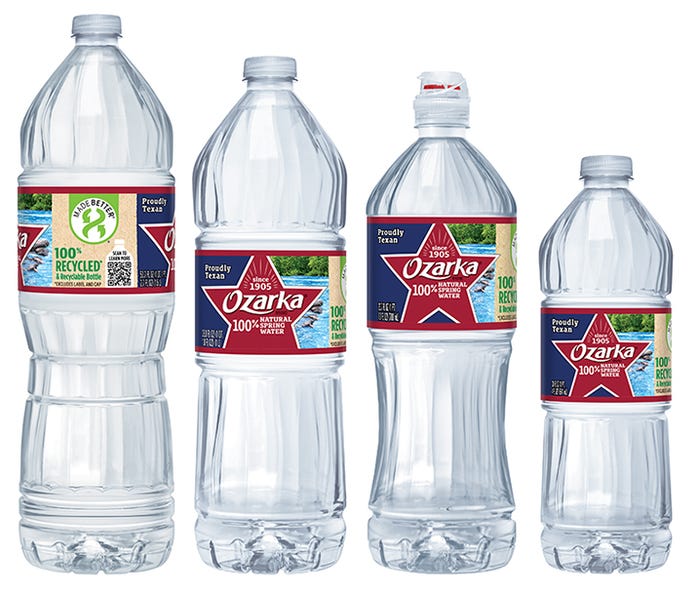
As a result, we have been able to manage the conversions of our production lines at a faster pace in most factories following our initial implementation for Poland Spring. Building the competence and having additional factory resources that everyone can learn from has been a very valuable contribution.
Recycled content aligns corporate action with consumer values.
Using recycled plastic in our packaging aligning with our consumers’ values and expectations of corporate action on important environmental and social issues.
For example, we are breathing new life into existing materials, reducing the need for new plastic and helping the beverage industry move toward a waste-free future. Using recycled plastic reduces greenhouse gases by 67% compared to using new plastic and supports the EPA’s estimated 757,000 jobs in recycling and reuse activities in the U.S. Furthermore, our brands can leverage our progress in using recycled content through various marketing activities. This summer, Ozarka will be launching a TV, digital and social media campaign this summer to inform Texans of the new rPET bottles. Understanding that bottles need to be recycled in order to create bottles with other bottles, Zephyrhills will be launching limited edition labels that encourage consumers to recycle through a bold message stating, ‘I’m Not Trash! I’m 100% Recyclable.’ This message will accompany the “100% recycled” message on the applicable bottle sizes
rPET proves that a circular plastics economy is possible.
Our 100% rPET bottles provide tangible proof that recycling works and the circular economy for plastics is achievable. We are focused on doing what we can to close the loop.
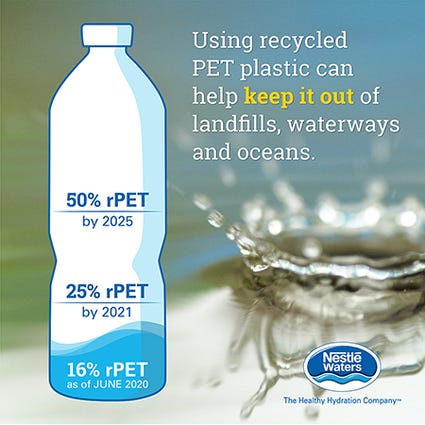
NWNA was the first beverage company to add How2Recycle information on the labels of our major U.S. brands, and in 2019, we collaborated with The Recycling Partnership to launch an Instagram recycling hotline to help Americans understand what is recyclable in their communities.
As a complement to the Instagram recycling hotline, we added QR codes on our labels, allowing consumers to follow the journey of their water, including what to do with the bottle when empty. We support recycling infrastructure through indirect investments, such as our $6 million investment in the Closed Loop Infrastructure Fund and we advocate for pragmatic policy, including minimum recycled content bills and the modernization of bottle deposit bills.
We’re also exploring alternative packaging options and thinking beyond the bottle to find new technologies and delivery systems that help us minimize environmental impact.
Ultimately, everyone has a role play. We are encouraged by the progress made already and will continue to work with industry, government and NGOs to help move toward a waste-free future.
You May Also Like


